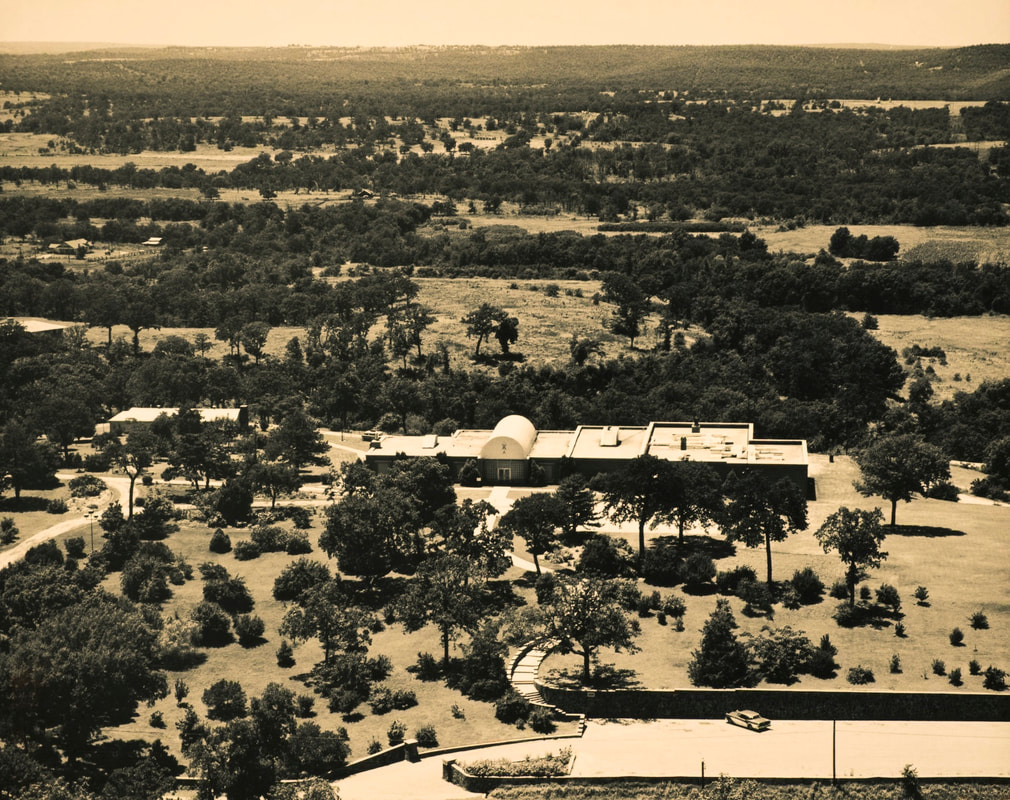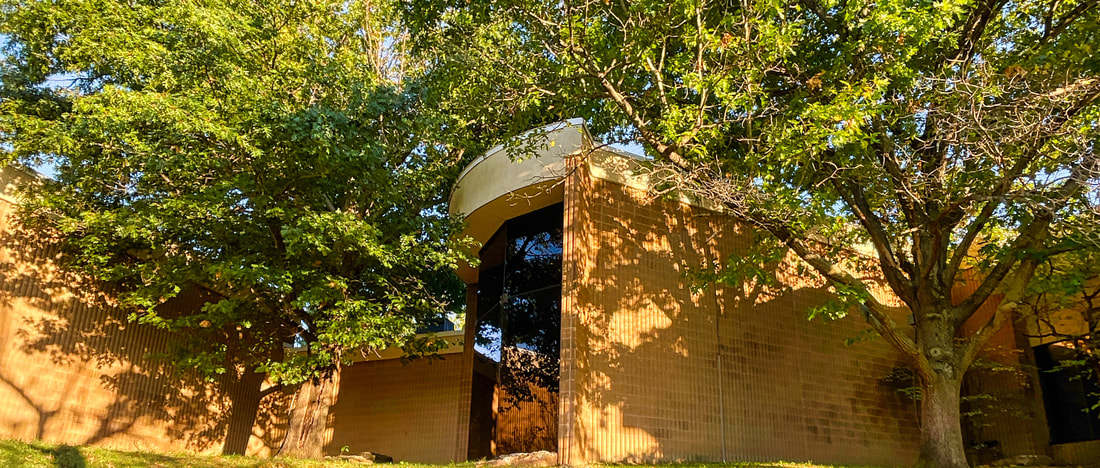rito del roble rojo
Autumn 2021
Gilcrease Museum is located three miles, give or take, northwest of downtown Tulsa, near the south eastern edge of Osage County. From the museums' current entrance looking east down the slope of the grounds is the mausoleum where Thomas Gilcrease was given his final resting place and a partial view of the city skyline..
This hill is part of the 13 acres that Thomas purchased and was part of the original allotment of Grover Mackey, an Osage Indian on the rolls as number 1499. The south half of the southeast quarter of Section 28, Township 20 Range 12 belonged to Grover and Pearl Mackey until they sold the land to a Tulsa. attorney Flowers Nelson and his wife Carrie in December 1909. Thomas purchased the land on December 26th, 1913. There was a stone house Nelson had built out of native sandstone, a barn and a garage.. The 460 acres that comprise the grounds of the museum, the mausoleum and the Gilcrease home are a unique and magical setting within the physical and historical boundaries of this city. Looking west from the home site the first ridge line of the Osage Hills is the crest of the horizon; it's where the land meets the sky. It's fitting this area was once known as Black Dog Township; named after a Chief of the Osage Tribe, an ancestral and native people who were finally able to purchase a permanent home. in the 1870's. The land became their reservation; the only remaining reservation of tribal territory in twentieth century Oklahoma, their source of tribal wealth and also the place that holds the stories of the dark events that followed. Clearly, beyond the beauty of the natural setting or the importance of the historical collection Thomas Gilcrease amassed and that remains housed on the land, the location holds even greater significance as the land of the Children of the Middle Waters. OSAGE, THE PEOPLE FROM THE STARS; ORIGIN STORY This is how the Osage origin story begins according to the Osage Nation Blog: "Wah-kon-da, the mystery force of the universe, sent the Osage down from the sky to be the caretakers of Earth, which they called the Sacred One.." "They divided themselves into two divisions called the Hunkah (the Earth people) who represented land and water and the Tzi-sho, who were the Sky people. This tribe would fully represent the universe that was made up of sky and Earth and land and water.." OSAGE TRADITIONS Reverend J. O. Dorsey, a 19th century missionary and ethnologist who conducted extensive research on Siouan tribes and languages. in his work for the Bureau of American Ethnology, visited Indian Territory in 1883. His work from that period led to his discovery of a sacred tradition preserved by a secret society of the Osage which is the source for the illustration below. The Red Oaks of Gilcrease
I am using this symbolic chart rendered to Reverend Dorsey 140 years ago as a core visual element of a site specific art work honoring the two red oak trees located on the northwest side of the museum. More specifics about the work here. In late 2021 or early 2022, the building will be razed to make way for what may perhaps become a more modern and efficient way to showcase and preserve this world class collection, although there will be sacrifices that have to be made for this progress. The two red oak trees, roble rojo, or quercus rubra were either natural vegetation or planted after the 1962 or the 1976 additions made to the existing building; a structure that has undergone numerous expansions after the original design by Alexandre Hogue in the late 1940's, early 1950's became the first Tulsa home of the Gilcrease collection. The trees are tucked away in niches of the building additions, almost invisible.. It is possible they are native and were calculated for in the design but is perhaps more likely they were planted after the fact. The calculations of a tree's age are best done by taking a core sample or by counting the rings; both processes were impractical for me since they are invasive to the tree.. My age calculations for the red oaks had them at 100+ years and were based upon a fairly common method of determining tree age by species but even though the results are subject to environmental conditions, the results appear to be far off the mark and incompatible with the aerial below. The Lowest Upper World
This version of the Osage tradition was dictated to Reverend Dorsey by an Osage named Red Corn, who took the name William P. Matthews but was known as Bill Nix.
(Link is to the image below which is part of the Gilcrease Museum online collection) Dorsey describes the various symbolic elements of the chart that Nix drew, mentioning that several of the Osage elders who were members of the secret order in which the traditions were preserved had tattooed portions of the chart on their chest and throats.
The chart is a pictorial depiction of the Osage cosmology, beginning at the top with the River of Life, passing through the sky with various stars, the sun and moon until reaching the center where a bird hovers over the four upper worlds, the final one of which rests upon a red oak tree. Below that is where the journey of the people began. The complete text of the Osage Tradition is available at the Internet Archive.. The Rite of the Red Oak
After the decision was made to raze the building I grappled with what seemed an insurmountable sense of loss; loss for the historical significance of the structure that seemed after all of the many changes than have occurred since Thomas and Alexander agreed upon a design that connected that moment with a not too distant past of a disappearing west, to be still somehow tethered to that time. But something even deeper than that was also in that emotion. As I have wandered this acreage for three years I have come to find solace in the rather magical place the property holds between the wild and the civilized world. Not quite truly of either, but loosely holding together the chasm between the two. The many small habitats that exist, the chattering, singing almost unnoticed world. The view of the two red oak looking west toward the Osage, toward the disappearing horizon of our past reminds me of the people who were here before, who believed in the interconnection of all species, who carried in their songs their traditions and who didn't simply deify the natural world but honored it within their daily existence, "rito del roble rojo" pays homage to these two red oaks, their holding of this lower world, knowing perhaps their time here is through, as one day. our time shall be.
|
|
|








